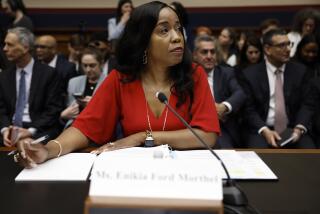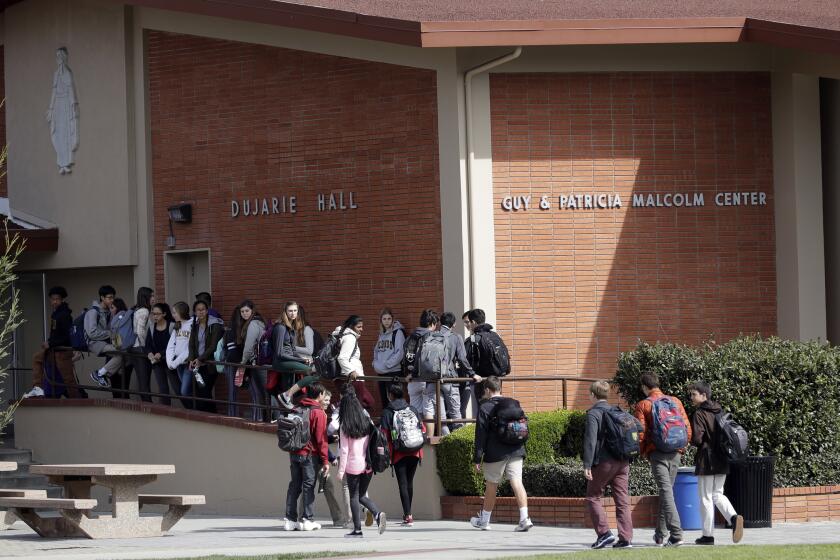Grass-Roots Crusade Targets Drug Scourge : Activism: The Orange County Congregation-Community Organizations is an emerging force for civic action. It has mobilized 50,000 member families in an effort to improve neighborhood life.
For Oliva de Leon, a housewife and mother living in an area where drug dealers peddle their wares from bicycles and gang wars puncture the silence of weekend nights, the last straw came when gang graffiti began appearing inside the Immaculate Heart of Mary Catholic Church.
Though she speaks little English and had only a scant formal education in her native Mexico, the defacing of her church was enough to catapult the 44-year-old mother of two boys into the role of a public crusader. Recently, she took the microphone before a crowd of 2,000 Orange County residents and elected officials to demand more solutions to the drug problems--something she said she never imagined she could do.
“It used to be that the churches were the one place that these gang members and drug dealers respected,” she said. “But now, they don’t even respect that. It is so depressing to me, when I kneel and see that stuff, but it also gives me the strength to keep on fighting.”
How people like Oliva de Leon have found the courage and skills to organize their own community to push for civic action is the secret behind a 6-year-old grass-roots organization that is enlisting thousands of foot soldiers in a crusade to improve life in Orange County neighborhoods.
It’s called the Orange County Congregation-Community Organizations, and it has grown to represent churches in 10 cities with 50,000 member families. With its broad-based membership, its religious foundation and the discipline of an army, OCCCO, as its members call it, is an emerging force for civic action. Recently the organization drew more than 2,000 people to an “action meeting” at the Century High School gymnasium in Santa Ana, an enthusiastic and organized crowd that called for solutions to the drug problem.
They have met with mayors, police chiefs and school officials in various cities and managed to secure a resolution from the County Board of Supervisors last year for more action on the drug war.
Yet many other officials throughout the county still know little about the group. Those who have had dealings with them predict that its renown will only grow.
“You’ve got a growing group here,” said Orange County Superior Court Judge David Carter, who attended the Century High School meeting. “Next time, they might fill the Santa Ana Bowl. It is giving the churches in Orange County a focal point.”
It may be the only organization of its size in the county that represents such a diverse population, culling its members from Catholic, Protestant and Jewish congregations. It is multidenominational, multi-ethnic and, organizers stress, nonpolitical. Most meetings are conducted in both Spanish and English--and sometimes even in Vietnamese. And members come from churches not only in poor communities, but also middle-class ones and others where people are concerned about community problems.
“It’s the only organization that I know of that tries to put more emphasis not on our differences, but our similarities,” said Raquel Estrada, a mortgage banker from Anaheim who is involved through St. Boniface Catholic Church. “We live in the same communities, we face the same problems with our families, we have the same fears of our kids becoming involved in drugs and we are working together to solve our problems. That’s what impressed me about this group.”
Their goal is simple: to combine religious and family values with a civic spirit, and then add the strict discipline of 1960s-style community organizing.
“It’s a chance for the common man to get involved and do something,” said Norma Leichtweis, a member of First Presbyterian Church of Anaheim.
“I think people would like to get involved, but they don’t because they don’t know how to bring about or create change,” she said. “It’s kind of a good feeling to know that you can make a difference.”
Church members say they are confident they are building solid relationships with officials and law enforcement agencies at the city and school levels, and they will continue to nurture that.
Some local officials agree. In Santa Ana, Lt. Robert Chavez, commander of the Central City area, said he has worked closely with the members of Immaculate Heart Church.
“We always tell people that the Police Department can’t solve all their problems, that they have to be willing to help themselves, and that’s just what this group is doing here,” he said.
“My personal feeling is, as commander of that area, that people like Oliva who are willing to mobilize their own community are doing a lot. I applaud them,” he said.
In Anaheim, members of First Presbyterian Church have provided police with information on activities at several “crack” houses, they said. Their help has led to numerous arrests, according to Capt. Roger Baker, special operations division commander.
“We’ve always had communications with the various churches within the community,” he said. “But what OCCCO has done is to assist the church groups in staying involved with us. It has given them continuity.
“I think their organization and participation is long overdue, and it’s a healthy sign and we welcome it,” he said.
The group evolved from the Orange County Sponsoring Committee, founded in 1976, which made headlines when it brought confrontational, and often controversial, organizing tactics to Orange County.
Business and church leaders here, recognizing a need to organize the county’s poorer neighborhoods, invited a team of four Jesuit priests from the Oakland Training Institute, a nonprofit community organizing group, to help organize people.
Three lay people started going door to door, searching for issues to mobilize the communities, and their tactics were based on the teachings of Saul D. Alinsky, whose Back of the Yards Council in Chicago in the 1930s became the model for activist community organizations nationwide.
The Santa Ana Neighborhood Organizations, organized by the sponsoring committee, stormed City Council meetings and politicians’ offices in the 1970s, sometimes carrying jars of cockroaches to demand improvements in neighborhoods without sidewalks, paved streets or gutters. Once they infuriated former Santa Ana Police Chief Raymond C. Davis when they gathered at his house after the chief had canceled a meeting with them, and they complained to his neighbors about his lack of cooperation.
By 1985, the Jesuit priests had moved on, and the sponsoring committee decided on a new tactic. Instead of having their organizers hunt for issues door to door, they would approach churches first, and if they found interest, they would help them organize. Thus, the congregation-community organization emerged, an umbrella group affiliated with similar community-interfaith groups in San Diego, Oakland, San Jose, Kansas City, New Orleans and Pensacola, Fla.
The congregation-community group’s leadership still includes the priests and ministers of several of the member churches, but its backbone consists of the church members who were driven to action by local concerns.
But about 1 1/2 years ago, the group’s members decided they were strong enough to tackle one issue at a time countywide. It was that first issue, the drug problem, that has brought them the only incident of “controversy” in recent years.
Supervisor Don R. Roth angered group leaders when he decided--at the last minute, according to the congregation-community group’s representatives--not to attend the group’s mass meeting June 18 at Century High School.
For their part, group members say they were stung and insulted by his refusal to meet with them.
Roth said he never agreed to attend in the first place, and that group leaders never fully explained to him who they were and what their purpose was.
Some of the congregation-community group’s leaders said Roth’s aide, Russ Barrios, told them the supervisor did not want to be put on the spot by the crowd of 3,000 that the organizers expected. If that is the case, church members said they are dismayed Roth would think they are confrontational or extremist.
“We’re not a radical group,” said Leichtweis of First Presbyterian Church of Anaheim. “How can fighting drugs be radical?
“We’re just a group of concerned church people who want to do something about conditions in this world,” she said. “I think Don Roth did more harm to himself by refusing to meet with 2,000 people concerned about the welfare of our families and communities. It’s disheartening and dismaying for me to think that we are electing the kind of officials who don’t even care what the people have to say.”
For Oliva De Leon, participation in the congregation-community organization has taken her places she had never dreamed of. Two years ago, she was one of a handful of church members whose way the group paid to attend a training workshop in New Orleans with others involved in the national organization of church-community groups. There, she struggled to understand the discussions, in English, about the importance of applying religious values to community issues. She came back a stronger person, and more determined to help her neighborhood.
More to Read
Start your day right
Sign up for Essential California for news, features and recommendations from the L.A. Times and beyond in your inbox six days a week.
You may occasionally receive promotional content from the Los Angeles Times.






